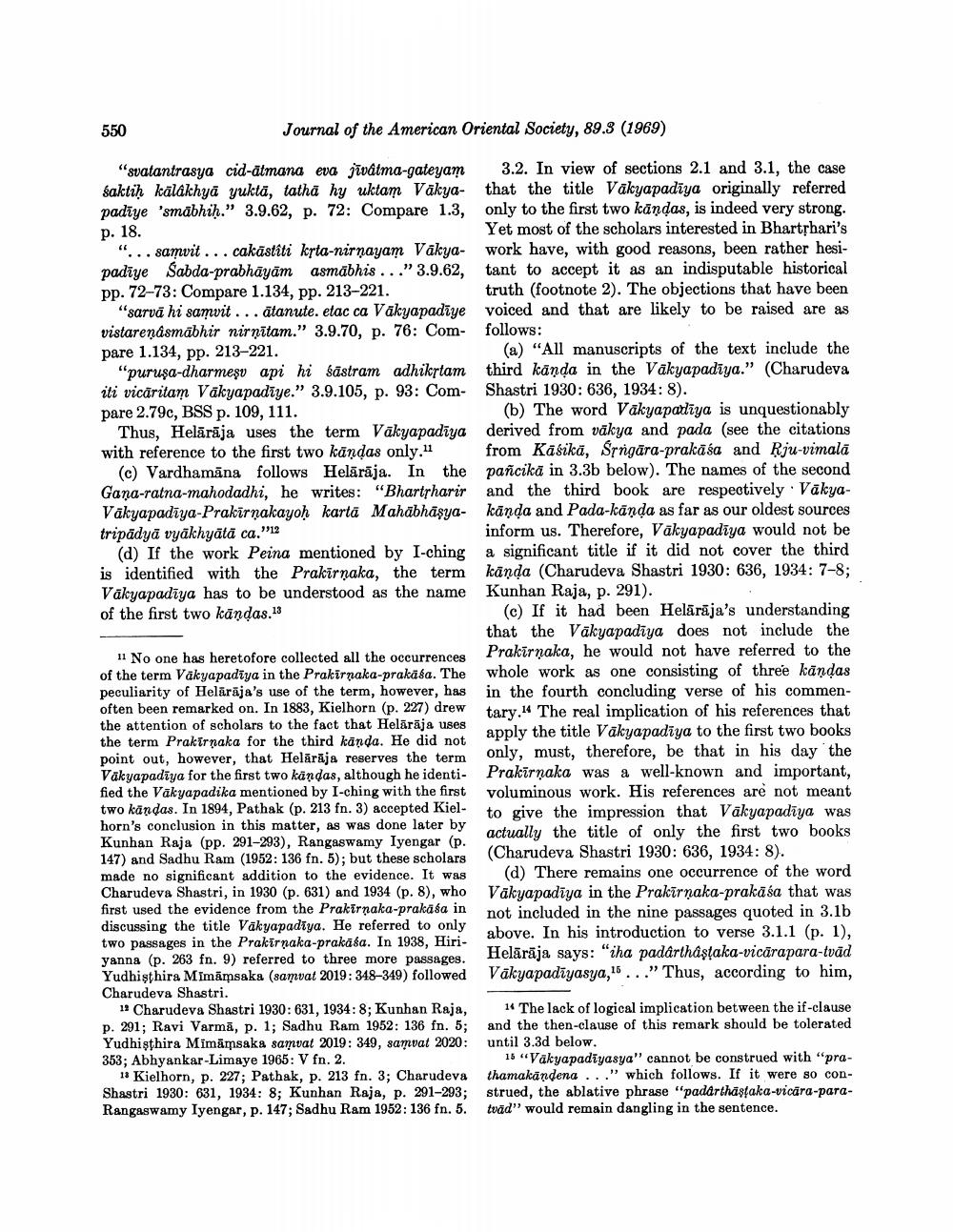Book Title: Two Textual Studies Of Bhartrhari Author(s): Ashok Aklujkar Publisher: Ashok Aklujkar View full book textPage 4
________________ 550 Journal of the American Oriental Society, 89.3 (1969) "svatantrasya cid-atmana eva jivâtma-gateyam saktiḥ kalákhya yukta, tatha hy uktam Vakyapadiye 'smabhiḥ." 3.9.62, p. 72: Compare 1.3, p. 18. "... samvit... cakāstiti krta-nirnayam Vakyapadiye Sabda-prabhāyām asmabhis..." 3.9.62, pp. 72-73: Compare 1.134, pp. 213-221. "sarva hi samvit... atanute. etac ca Vakyapadiye vistarenâsmabhir nirnītam." 3.9.70, p. 76: Compare 1.134, pp. 213-221. "purusa-dharmeşu api hi sastram adhikrtam iti vicaritam Vakyapadiye." 3.9.105, p. 93: Compare 2.79c, BSS p. 109, 111. Thus, Helārāja uses the term Vakyapadiya with reference to the first two kanḍas only." (c) Vardhamana follows Heläraja. In the Gana-ratna-mahodadhi, he writes: "Bhartrharir Vakyapadiya-Prakirṇakayoḥ karta Mahabhaṣyatripádya vyakhyālā ca." (d) If the work Peina mentioned by I-ching is identified with the Prakirnaka, the term Vakyapadiya has to be understood as the name of the first two kāṇḍas.13 No one has heretofore collected all the occurrences of the term Vakyapadiya in the Prakirnaka-prakasa. The peculiarity of Helārāja's use of the term, however, has often been remarked on. In 1883, Kielhorn (p. 227) drew the attention of scholars to the fact that Helārāja uses the term Prakirnaka for the third kända. He did not point out, however, that Heläraja reserves the term Vakyapadiya for the first two kändas, although he identified the Vakyapadika mentioned by I-ching with the first two kändas. In 1894, Pathak (p. 213 fn. 3) accepted Kielhorn's conclusion in this matter, as was done later by Kunhan Raja (pp. 291-293), Rangaswamy Iyengar (p. 147) and Sadhu Ram (1952: 136 fn. 5); but these scholars made no significant addition to the evidence. It was Charudeva Shastri, in 1930 (p. 631) and 1934 (p. 8), who first used the evidence from the Prakirnaka-prakasa in discussing the title Vakyapadiya. He referred to only two passages in the Prakirnaka-prakasa. In 1938, Hiriyanna (p. 263 fn. 9) referred to three more passages. Yudhisthira Mimamsaka (samvat 2019: 348-349) followed Charudeva Shastri. 12 Charudeva Shastri 1930: 631, 1934: 8; Kunhan Raja, p. 291; Ravi Varma, p. 1; Sadhu Ram 1952: 136 fn. 5; Yudhisthira Mimämsaka samvat 2019: 349, samvat 2020: 353; Abhyankar-Limaye 1965: V fn. 2. 13 Kielhorn, p. 227; Pathak, p. 213 fn. 3; Charudeva Shastri 1930: 631, 1934: 8; Kunhan Raja, p. 291-293; Rangaswamy Iyengar, p. 147; Sadhu Ram 1952: 136 fn. 5. 3.2. In view of sections 2.1 and 3.1, the case that the title Vakyapadiya originally referred only to the first two kändas, is indeed very strong. Yet most of the scholars interested in Bhartṛhari's work have, with good reasons, been rather hesitant to accept it as an indisputable historical truth (footnote 2). The objections that have been voiced and that are likely to be raised are as follows: (a) "All manuscripts of the text include the third kända in the Vakyapadiya." (Charudeva Shastri 1930: 636, 1934: 8). (b) The word Vakyapathiya is unquestionably derived from vakya and pada (see the citations from Käsika, Śrngāra-prakāśa and Ṛju-vimalā pañcikä in 3.3b below). The names of the second and the third book are respectively Vakyakāṇḍa and Pada-kanṇḍa as far as our oldest sources inform us. Therefore, Vakyapadiya would not be a significant title if it did not cover the third kanda (Charudeva Shastri 1930: 636, 1934: 7-8; Kunhan Raja, p. 291). (c) If it had been Helāraja's understanding that the Vakyapadiya does not include the Prakirṇaka, he would not have referred to the whole work as one consisting of three kändas in the fourth concluding verse of his commentary.14 The real implication of his references that apply the title Vakyapadiya to the first two books only, must, therefore, be that in his day the Prakirnaka was a well-known and important, voluminous work. His references are not meant to give the impression that Vakyapadiya was actually the title of only the first two books (Charudeva Shastri 1930: 636, 1934: 8). (d) There remains one occurrence of the word Vakyapadiya in the Prakirnaka-prakāśa that was not included in the nine passages quoted in 3.1b above. In his introduction to verse 3.1.1 (p. 1), Helārāja says: "iha padârthâşṭaka-vicarapara-tväd Vakyapadiyasya,15..." Thus, according to him, 14 The lack of logical implication between the if-clause and the then-clause of this remark should be tolerated until 3.3d below. 15 "Vakyapadiyasya" cannot be construed with "prathamakandena..." which follows. If it were so construed, the ablative phrase "padarthāṣṭaka-vicara-paratvad" would remain dangling in the sentence.Page Navigation
1 2 3 4 5 6 7 8 9 10 11 12 13 14 15 16 17
